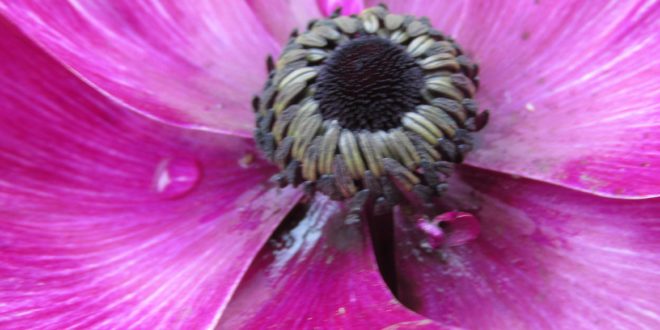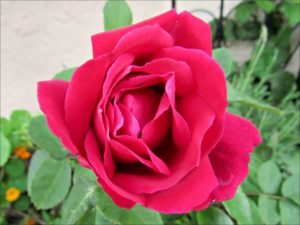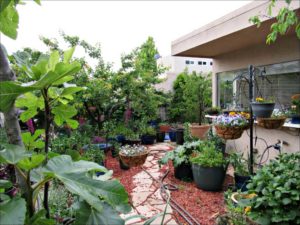 April is always a great time in our Sunnyvale garden. The last few rain showers end by mid April. The spring bulbs finish their blossoms as the vines start blooming and the summer bulbs start peeking out from the ground. The tomato plants are already 2-3 feet tall and have blossoms. The citrus trees (orange, tangerine, grapefruit, lemon, lime) attracted lots of bees during the month. About mid-April, the blackberry and marionberry canes began blooming. The tuberous begonias emerge from the winter slumber and are a foot tall.
April is always a great time in our Sunnyvale garden. The last few rain showers end by mid April. The spring bulbs finish their blossoms as the vines start blooming and the summer bulbs start peeking out from the ground. The tomato plants are already 2-3 feet tall and have blossoms. The citrus trees (orange, tangerine, grapefruit, lemon, lime) attracted lots of bees during the month. About mid-April, the blackberry and marionberry canes began blooming. The tuberous begonias emerge from the winter slumber and are a foot tall.
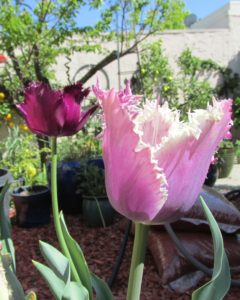 Last of the Ruffled Tulips. The majority of tulips flower naturally in the spring, making them a symbol of new life and renewal. Mix early-flowering daffodils with midseason or late-blooming tulips in a single bed to create a colorful spring display and can increase the flowering period. Both flowers grow best with full, all-day sunlight and have similar care needs, making them amiable companions. Our local high school has a spectacular display of tulips. Check out Marie’s Flickr account for many photos.
Last of the Ruffled Tulips. The majority of tulips flower naturally in the spring, making them a symbol of new life and renewal. Mix early-flowering daffodils with midseason or late-blooming tulips in a single bed to create a colorful spring display and can increase the flowering period. Both flowers grow best with full, all-day sunlight and have similar care needs, making them amiable companions. Our local high school has a spectacular display of tulips. Check out Marie’s Flickr account for many photos.
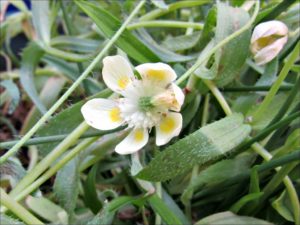 Beauty in a small package: California Creamcup , has a one inch wide flower with six petals which may be pure white or golden or white with large gold spots or gold tips. The center of the flower is filled with a tuftlike cluster of many thick, flattened stamens. The small plant (12×18 inches) may produce hundreds of blossoms. The fruit is a capsule with several one-seeded sections that break apart. Platystemon californicus, is an annual herb that is native to California and is also found outside of California, but is confined to western North America.
Beauty in a small package: California Creamcup , has a one inch wide flower with six petals which may be pure white or golden or white with large gold spots or gold tips. The center of the flower is filled with a tuftlike cluster of many thick, flattened stamens. The small plant (12×18 inches) may produce hundreds of blossoms. The fruit is a capsule with several one-seeded sections that break apart. Platystemon californicus, is an annual herb that is native to California and is also found outside of California, but is confined to western North America.
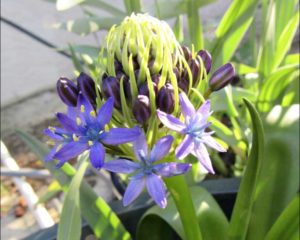 Scilla peruviana is a evergreen perennial makes a spring-time statement with 50 to 100 deep-blue, starry blossoms atop large, cone-shaped flowers. Grow it alongside other spring flowering bulb crops such as daffodils, hyacinths and tulips. These unique flowers have an impressively long bloom time. This is the first year we have tried this flower and it is worth trying.
Scilla peruviana is a evergreen perennial makes a spring-time statement with 50 to 100 deep-blue, starry blossoms atop large, cone-shaped flowers. Grow it alongside other spring flowering bulb crops such as daffodils, hyacinths and tulips. These unique flowers have an impressively long bloom time. This is the first year we have tried this flower and it is worth trying.
Scilla peruviana is native from southwestern Europe to western Africa. Plants were collected in Spain in the 17th century and shipped to England on a ship named “The Peru” but when later naming the plant Linnaeus thought the plant originated in the South American country of Peru and named the plant for its supposed origin.
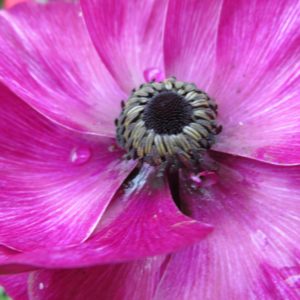 Iceland poppies are hardy but short-lived perennials, often grown as biennials, that yield large, papery, bowl-shaped, lightly fragrant flowers supported by hairy, one foot, curved stems among feathery blue-green foliage 1-6 inches long. This year’s crop was planted in our former fire-pit surrounded by cool-weather cyclamen and english daisy. They bloom in April after the crocus, hyacinth, and tulips.
Iceland poppies are hardy but short-lived perennials, often grown as biennials, that yield large, papery, bowl-shaped, lightly fragrant flowers supported by hairy, one foot, curved stems among feathery blue-green foliage 1-6 inches long. This year’s crop was planted in our former fire-pit surrounded by cool-weather cyclamen and english daisy. They bloom in April after the crocus, hyacinth, and tulips.
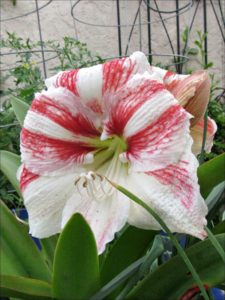 Amaryllis bulbs are easy enough to grow indoors, and just as easy to grow in the garden provided you live in a suitable region. They make great specimens outdoors. They perform well in beds, borders or containers outside. You can also scatter them throughout the landscape in naturalized areas. These plants look exceptionally attractive when planted in groups.
Amaryllis bulbs are easy enough to grow indoors, and just as easy to grow in the garden provided you live in a suitable region. They make great specimens outdoors. They perform well in beds, borders or containers outside. You can also scatter them throughout the landscape in naturalized areas. These plants look exceptionally attractive when planted in groups.
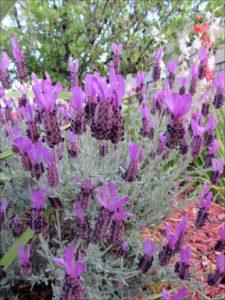 Loved by bees, Spanish Lavender will make your garden hum with life. Spanish Lavender (Lavandula stoechas) is a good choice for those who garden in hot humid climates.The antiseptic, piney fragrance of Spanish Lavender makes it an exceptionally fragrant landscape plant but not the first choice for use in cooking. English Lavenders, both Lavandula angustifolias and Lavandula x intermedias, are preferred in the kitchen.
Loved by bees, Spanish Lavender will make your garden hum with life. Spanish Lavender (Lavandula stoechas) is a good choice for those who garden in hot humid climates.The antiseptic, piney fragrance of Spanish Lavender makes it an exceptionally fragrant landscape plant but not the first choice for use in cooking. English Lavenders, both Lavandula angustifolias and Lavandula x intermedias, are preferred in the kitchen.
Spanish Lavender is probably what the ancient Greeks and Romans used to scent their bath water. Indeed the word Lavender is from Latin lavare (to wash).
Spanish Lavender blooms profusely in the spring and when it finishes it needs a good pruning. The result will be an attractive, fragrant, gray-green shrub throughout the rest of the year.
This Mulberry bush continuously produces sweet blackberry-like fruit throughout the season. A great choice for container gardening; minor pruning will keep the plant compact. Mature height is 6 to 8 feet if grown in the ground.
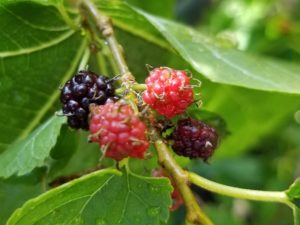
I grow it in a 20 inch wide and deep ceramic pot. It is about 6-7 feet tall from the soil.
The mulberry flowers in March are almost microscopic. In mid-April the fruit is the size of pencil erasers. The fruits start darkening and, unlike blackberries, continue to grow. The berries get sweeter. Question: When do you know when mulberries are ripe? Answer: The day before the squirrels start eating them!
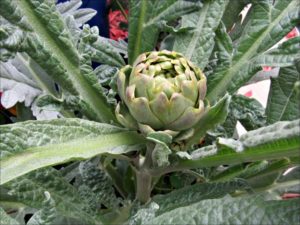 2017 is the first time I have tried artichokes in our Sunnyvale garden. I planted two varieties: Romanesco and Violetta. I skipped the most common local variety in Central California, Green Globe, because I can get those any day. I planted them in 10-gallon containers. Most local artichokes are grown on the coast in cool marine climates like Castroville. I am in South San Francisco Bay so I need to water them everyday, otherwise they wilt. On May 7, I harvested the first crop and they were delicious.
2017 is the first time I have tried artichokes in our Sunnyvale garden. I planted two varieties: Romanesco and Violetta. I skipped the most common local variety in Central California, Green Globe, because I can get those any day. I planted them in 10-gallon containers. Most local artichokes are grown on the coast in cool marine climates like Castroville. I am in South San Francisco Bay so I need to water them everyday, otherwise they wilt. On May 7, I harvested the first crop and they were delicious.
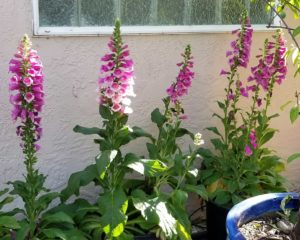 This year we have a bumper crop of Foxglove (Digitalis purpurea). This biennial plant is often grown as an ornamental plant due to its vivid flowers which range in colour from various purple tints through various shades of light gray, and to purely white. The flowers can also possess various marks and spottings.
This year we have a bumper crop of Foxglove (Digitalis purpurea). This biennial plant is often grown as an ornamental plant due to its vivid flowers which range in colour from various purple tints through various shades of light gray, and to purely white. The flowers can also possess various marks and spottings.
The first year of growth of the common foxglove produces only the stem with its long, basal leaves. During the second year of the plant’s life, a long, leafy stem from 50 to 255 centimetres tall grows atop the roots of healthy plants. The plant is some productive that I discard extra plants as weeds.
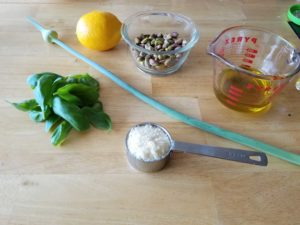 I always grow lots of garlic and elephant garlic in our Sunnyvale Garden. During their growing season, all of them start to develop stalks (called scapes) with flower heads. If you want larger garlic heads, then cut off the scapes before the flower head blossoms. You can use the garlic-scapes as a mild version of garlic in many recipes. I tried a Garlic-scape and Basil pesto sauce using 1 elephant garlic scape with some basil and lemon from the garden, along with some pistacho nuts.
I always grow lots of garlic and elephant garlic in our Sunnyvale Garden. During their growing season, all of them start to develop stalks (called scapes) with flower heads. If you want larger garlic heads, then cut off the scapes before the flower head blossoms. You can use the garlic-scapes as a mild version of garlic in many recipes. I tried a Garlic-scape and Basil pesto sauce using 1 elephant garlic scape with some basil and lemon from the garden, along with some pistacho nuts.
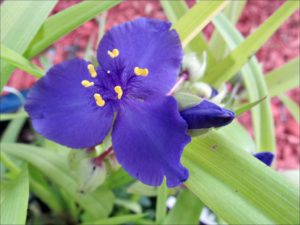 ‘Sweet Kate’ is a compact, clump-forming, hybrid spiderwort that is noted for its unique yellow foliage. It typically grows to 12” tall. Three-petaled, purplish-blue flowers (to 1.5” diameter) accented by contrasting yellow stamens are borne in terminal clusters (umbels) atop stiff stems. Numerous flower buds form in each cluster, but individual flowers open up only a few at a time, each for only one day, blooming in succession from May into summer. Arching, iris-like, bright yellow leaves are folded lengthwise forming a groove. When the stems of spiderworts are cut, a viscous stem secretion is released which becomes thread-like and silky upon hardening (like a spider’s web), hence the common name. Genus name honors John Tradescant (1570-1638) and his son John Tradescant (1608-1662), botanists and successive gardeners to Charles I of England.
‘Sweet Kate’ is a compact, clump-forming, hybrid spiderwort that is noted for its unique yellow foliage. It typically grows to 12” tall. Three-petaled, purplish-blue flowers (to 1.5” diameter) accented by contrasting yellow stamens are borne in terminal clusters (umbels) atop stiff stems. Numerous flower buds form in each cluster, but individual flowers open up only a few at a time, each for only one day, blooming in succession from May into summer. Arching, iris-like, bright yellow leaves are folded lengthwise forming a groove. When the stems of spiderworts are cut, a viscous stem secretion is released which becomes thread-like and silky upon hardening (like a spider’s web), hence the common name. Genus name honors John Tradescant (1570-1638) and his son John Tradescant (1608-1662), botanists and successive gardeners to Charles I of England.
We are growing our Sweet Kate in a low wide bowl under the cherry tree in our Sunnyvale garden.
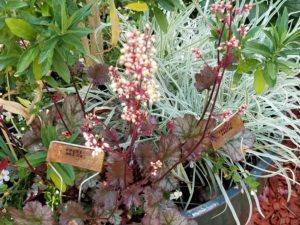 Coral bells (Heuchera) may also be known by alumroot. These perennial plants are hardy to USDA plant hardiness zone 3 and though they’re usually listed as evergreens in many climates, they can actually be found in several foliage colors—like bronze, purple, and more. The spikes of tall, bell-shaped blooms is where the coral bells flowers get their name and are just as impressive as the foliage color, blooming in late spring to early summer. There are also late-blooming types available. The flower color varies too, with colors ranging from white and pink to light coral and deep red.
Coral bells (Heuchera) may also be known by alumroot. These perennial plants are hardy to USDA plant hardiness zone 3 and though they’re usually listed as evergreens in many climates, they can actually be found in several foliage colors—like bronze, purple, and more. The spikes of tall, bell-shaped blooms is where the coral bells flowers get their name and are just as impressive as the foliage color, blooming in late spring to early summer. There are also late-blooming types available. The flower color varies too, with colors ranging from white and pink to light coral and deep red.
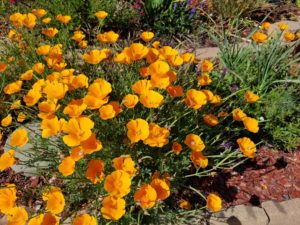 Home gardeners growing California poppies (Eschscholzia californica) are rewarded with their fern-like foliage and lively orange, red and yellow flowers. Easy going, drought-tolerant plants are a favorite for use in container gardens, mixed beds, rock gardens and waterwise (xeric) landscapes.
Home gardeners growing California poppies (Eschscholzia californica) are rewarded with their fern-like foliage and lively orange, red and yellow flowers. Easy going, drought-tolerant plants are a favorite for use in container gardens, mixed beds, rock gardens and waterwise (xeric) landscapes.
I last planted California poppies 35 years ago. Every spring they appear all over the front yard. I remove the strays and enjoy the daytime blossoms.
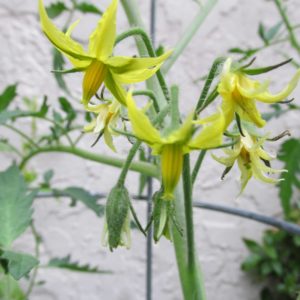 We cut back on our tomato plants for 2017: Only 40 plants of 9 varieties!
We cut back on our tomato plants for 2017: Only 40 plants of 9 varieties!
The plants were grown from seed (from TomataFest.com) starting indoors in January.
In March I transplanted them to gallon pots.
In April I transplanted them into their final 5 to 10 gallon pots. The tomato plants are 2 to 3 feet tall now and they all have blossoms. I climbed onto the flat roof and retrieved the tomato cages from their winter storage site.
I am still waiting for the first fruits.
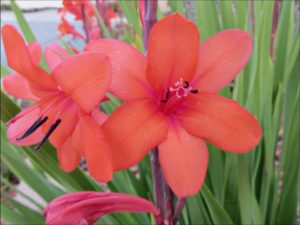 Watsonia bulbs are an excellent example of how simple gardening can be when the right plant is matched to suitable growing conditions. Fresh watsonia bulbs are available from early September through mid November only. They naturalize so you can leave them in the soil for next year.
Watsonia bulbs are an excellent example of how simple gardening can be when the right plant is matched to suitable growing conditions. Fresh watsonia bulbs are available from early September through mid November only. They naturalize so you can leave them in the soil for next year.
We have not bought watsonia for over twenty years. Whenever I want it in another location, I just transplant a few bulbs.
Watsonia will form sizeable clumps over time and eventually flowering will diminish. When this occurs, dig up the clump and separate it into a number of smaller plants. Distribute them around your garden or share with friends. Replant promptly.
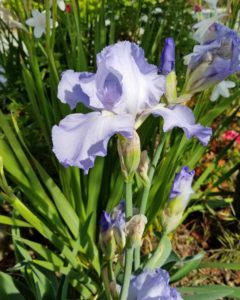 April is always the month for our Bearded Iris plants. We have a blue variety and a peach variety. Tall Bearded Iris is a great spring flower for Sunnyvale gardens.
April is always the month for our Bearded Iris plants. We have a blue variety and a peach variety. Tall Bearded Iris is a great spring flower for Sunnyvale gardens.
Ours is a migrant plant. Some years the iris is in the front yard in the ground; other years the iris is in a container in the back yard.
Iris will thrive in most well-drained garden soils. Planting on a slope or in raised beds helps ensure good drainage. If your soil is heavy, coarse sand or humus may be added to improve drainage.
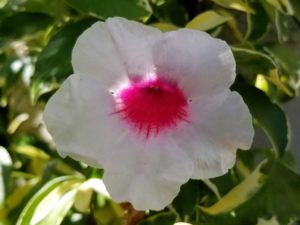 Bower Vine, Jasmine, Pandorea jasminoides. Pink bower vine is a fast-growing vine that reaches heights of 20 to 30 feet at maturity. We grow ours in a 3 inch wide crack on a south-facing wall. The vine adds color to the landscape all summer, displaying soft pink, bell-shaped blooms with dark pink throats. Thanks to the lush, evergreen foliage, the vine is attractive even when it isn’t blooming. Bower vine is suitable for planting in U.S. Department of Agriculture plant hardiness zones 9 to 11 (which is fine for Sunnyvale which is 9a).
Bower Vine, Jasmine, Pandorea jasminoides. Pink bower vine is a fast-growing vine that reaches heights of 20 to 30 feet at maturity. We grow ours in a 3 inch wide crack on a south-facing wall. The vine adds color to the landscape all summer, displaying soft pink, bell-shaped blooms with dark pink throats. Thanks to the lush, evergreen foliage, the vine is attractive even when it isn’t blooming. Bower vine is suitable for planting in U.S. Department of Agriculture plant hardiness zones 9 to 11 (which is fine for Sunnyvale which is 9a).
 Aeonium arboreum ‘Schwartzkopf’ is a cultivar with glossy satiny rosettes so dark as to appear black. It will keep this color even in winter as long as it has sunlight. Native to the Canary Islands, Aeoniums do well in our Sunnyvale climate but need protection from frost.
Aeonium arboreum ‘Schwartzkopf’ is a cultivar with glossy satiny rosettes so dark as to appear black. It will keep this color even in winter as long as it has sunlight. Native to the Canary Islands, Aeoniums do well in our Sunnyvale climate but need protection from frost.
Like most succulents, it does extremely well in drought. It reproduces easily from cuttings. Its soil requirements are easily reached.
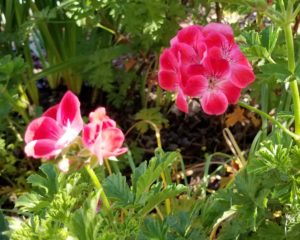 Geraniums (Pelargonium x hortorum) make popular bedding plants in the garden, but they’re also commonly grown indoors or outside in hanging baskets. This particular type of geranium we grow outdoors in the front yard. It benefitted greatly from this winter’s rains.
Geraniums (Pelargonium x hortorum) make popular bedding plants in the garden, but they’re also commonly grown indoors or outside in hanging baskets. This particular type of geranium we grow outdoors in the front yard. It benefitted greatly from this winter’s rains.
Geraniums can generally very hardy but expect some die-off from frost.
